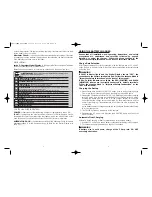
5
USING THE BATTERY CHARGER
Ensure that all installation and operating instructions, and safety
precautions are understood and carefully followed by anyone
installing or using the charger. Follow the steps outlined in the
“Important Safety Instructions” at the front of this User’s Manual.
Charge Rate Selection
After charger clamps are correctly connected, plug the charger into a 120 volt AC
outlet. The power indicator light will light. Select the proper charge current rate based
on battery size.
WARNING
If FAULT indicator lights and the Digital Display shows “F02”, the
connection to the battery terminals is bad. Follow the steps outlined in
“Important Safety Instructions” at the front of this manual.
If Rev. Polarity indicator also lights, the RED (POSITIVE) and BLACK
(NEGATIVE) clamps are incorrectly connected to battery terminals.
Follow the steps outlined in “Important Safety Instructions” at the
front of this manual.
Charging the Battery
1. Press Charge Rate Selector 2A/6A/10A button once to begin charging at the
2 amp rate; the unit sounds a beep and the charging current LED lights.
2. Pressing the Charge Rate Selector 2A/6A/10A button again advances charging
rate to 4 amps, and pressing once more advances charging rate to 6 amps.
(Pressing the button again will turn OFF the charger output.) This selection
and actual battery charge rate are monitored by the microprocessor and the
unit will stop charging if the selected rate is too fast or too slow for battery size
or condition.
As the battery nears full charge capacity, the unit’s output will automatically drop
to a lower charge rate.
3. The FUL LED lights when the battery is fully charged.
4. Disconnect the AC power cord first, then the NEGATIVE clamp, and finally the
POSITIVE clamp.
Automatic Float Charging
Automatic Float Charging is ideal for maintaining a fully charged battery.
1. Keep the 120 volt AC power and battery connected after battery is fully charged.
2. The charger monitors the battery and tops it off as needed.
WARNING
If battery size is not known, charge at the 2 Amp rate. DO NOT
overcharge batteries.
4
by the microprocessor. The charger will stop charging if the rate is too fast or too slow
for the battery size or condition.
Alternator Check —
is a quick check that measures the battery voltage. This check
is repeated at various electrical load levels and the tests allow the user to determine
if the alternator can keep up with the loads.
DIGITAL DISPLAY:
Large 3-Character Digital Display
in the upper left of the control panel indicates
the various conditions and/or status codes:
Status Codes
are described in the following chart and on the back of the unit.
CONTROL PANEL LED INDICATORS:
POWER —
lights when either the Battery Charger or Jump-Starter is turned ON.
FAULT —
lights when when a fault condition is present. The Digital Display will show
the appropriate Fault Code (refer to the chart above, which can also be found on the
back of the unit). Consult the above Status Code Chart for more information.
ALTERNATOR GOOD —
lights at the conclusion of the Alternator Check to indicate
alternator voltage is within operating range. (Otherwise, the Digital Display with
show F07.)
AC POWER INDICATOR -
When connected to an AC outlet, digital display shows circulating pattern to
indicate power is on. Disconnect charger after use.
FAULT CODES
OPERATION CODES
F01
F02
F03
F04
F05
F06
F07
000
FUL
INTERNAL SHORTED CELL BATTERY -
Cannot be charged. Have battery checked by certified auto service center.
EXCESSIVE LOAD ON BATTERY WHILE CHARGING -
Check load.
BAD BATTERY CONNECTION -
Check battery connection.
BATTERY VOLTAGE TOO LOW TO ACCEPT CHARGE -
Have battery checked by certified auto service center.
BATTERY RECONDITIONING -
(The letters
DES
will display for the first 3 seconds.)
INTERNAL OPEN CELL -
Have battery checked by certified auto service center.
SULFATED CONDITION -
Battery needs to be reconditioned. See manual.
OVERHEATED CONDITION -
Disconnect charger and allow to cool for 30 min., check for ample ventilation.
REVERSE POLARITY
ALTERNATOR OUTPUT IS OUT OF TYPICAL OPERATION RANGE
ALTERNATOR VOLTAGE CHECK
CHARGER STANDBY
BATTERY FULLY CHARGED
OVERTIME CONDITION -
Battery will not accept a charge after 18 hours of continuous charging. Battery may have
internal damage. Have battery checked by certified auto center.
BATTERY CHARGE RATE IS SET TOO LOW -
Set charger to higher charge rate. See manual.
VEC012BBD_ManualEN_020106 2/1/06 3:13 PM Page 4








